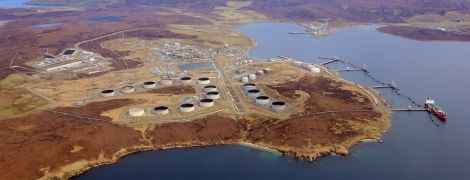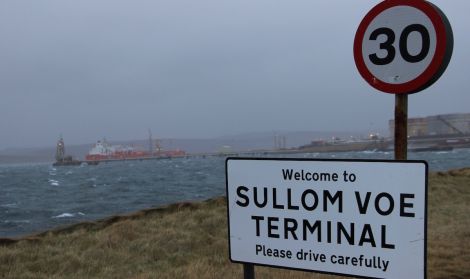Energy / Cutting carbon emissions at Sullom Voe key target of new energy project
REDUCING CO2 emissions at Sullom Voe Terminal (SVT) and the port of Sullom Voe by 200,000 tonnes a year within the next ten years using renewable energy is one of a number of aims included in a blueprint for the future of Shetland’s energy sector.
Other objectives for Sullom Voe include maximising recovery of west of Shetland and east of Shetland oil through the terminal at a level of 200,000 barrels a day by 2025 using existing infrastructure.
Currently the throughput at SVT is between 80,000 and 140,000 barrels of oil a day, sourced from the east of Shetland and the Clair field.
There is also an aim to make the shoreside facilities at the port of Sullom Voe greener and identify dates to bring all vessels in line with national carbon reduction policies.
The objectives are included in a report on the Shetland Energy Hub project, which is due to be presented to councillors next week.
The Shetland Islands Council-led project aims to prolong activity in the local oil and gas sector while at the same time integrating the move towards low carbon solutions and renewable energy.
This could include diversifying activity at Sullom Voe Terminal away from hydrocarbons and move it more towards greener energy.
The project was first called the Sullom Voe Hub, but its name has been broadened to reflect the “growing influence of the important climate change debate, which has now become a guiding principle for the oil and gas industry”.
The port of Sullom Voe is considered a key asset for Shetland Islands Council, particularly in the income it generates for the local authority and the impact it has on the wider Shetland economy, as well as its environmental sensitivity.
With over 1,000 people employed in the energy sector locally, “retaining Shetland’s status as an energy centre, at a time when there are fundamental shifts in the energy industry towards low carbon solutions is therefore an essential proposition”, according to a report from infrastructure director John Smith and development chief Neil Grant.
Become a member of Shetland News
One of the main purposes of the project is to promote green energy projects through Shetland and offshore as part of the international drive to achieve net zero carbon emissions by 2045.
It also wants to make full use of the natural energy resources in the isles, and to work with the oil and gas industry to “optimise existing and developing infrastructure in the hydrocarbon sector and energy transition opportunities”.
Success of the project could see over 500 people employed in a net zero carbon energy industry in Shetland in 2045, the report claims.
Next week councillors will be asked to approve the establishment of a board to take the project forward, and deploy staffing and resources for an initial three-year period.
They will also be asked to endorse the commissioning of an “experience energy industry specialist to guide a visioning scape for the project”, and for staff to prepare a strategic outline programme.
The estimated cost of the project is £250,000 over an initial period of three years, which will be financed from the council’s harbour account.
The progress on the project comes at a time when Shetland Islands Council is looking to be more proactive in tacking climate change, with a report on the matter also being presented to councillors next week.
Sullom Voe Terminal, its power station and the neighbouring Shetland Gas Plant are high polluters of CO2 when it comes to the national picture in Scotland.
Figures from SEPA show that SVT’s power station released 229,000 tonnes of CO2 in 2017 while the terminal itself emitted 77,320 tonnes. The gas plant, operated by Total, released 239,000 tonnes of CO2 during the year.
The energy hub report says it is estimated that the offshore industry linked to the terminal and gas plant emits over six million tonnes of CO2 every year.
The aim to reduce emissions at Sullom Voe Terminal and the port come at a time when operator EnQuest is looking to “radically change” the power set-up at the terminal, which features a gas-fired station, as part of a transformation programme to simply the make-up of the SVT site.
A 600MW subsea interconnector – which would link Shetland to the national grid for the first time – is vying for the green light from energy regulator Ofgem, and this could open up new opportunities for the oil and gas sector to tap into more ‘green’ sources of energy.
The energy hub project also comes as EnQuest remains locked in discussions with energy giant BP over how oil from the Clair field will be exported in the future.
The oil is currently taking via pipeline into Sullom Voe Terminal, but if BP decides to bypass Shetland then it is estimated that SVT could be forced to close its doors as early as 2025.
EnQuest has been trying to cut costs at the site since taking over from BP in 2017 in a bid to attract new business, and it has already reduced operating costs by one quarter to £150 million, with job cuts announced last year.
The energy hub report, meanwhile, says that specific aims for Sullom Voe elements of the project have been established following a workshop in August last year.
They also include:
- Maximising recovery from West of Shetland and North of Shetland gas at a level of 20 million scm a day by 2025, using existing infrastructure
- Identify and progress an energy transition strategy for Sullom Voe to diversify some activity away from established hydrocarbon forms into new technologies such as LNG, gas to hydrogen, gas to wire and carbon capture
- Attract renewable energy generating and supplying businesses into Sullom Voe Hub Project area to develop alternative energy sources, including onshore and offshore wind projects
- Develop a partnership between Sullom Voe decommissioning activities, local suppliers and the Dales Voe decommissioning project to maximise benefits from onshore and offshore decommissioning activities
- Develop, in partnership with the oil and gas industry, a consolidated pollution response base to serve the northern North Sea area and SVT
- Prior to decommissioning, establish with main stakeholders if there is any future strategic or commercial use for redundant oil storage tanks, jetties and other significant assets
Become a member of Shetland News
Shetland News is asking its readers to consider paying for membership to get additional perks:
- Removal of third-party ads;
- Bookmark posts to read later;
- Exclusive curated weekly newsletter;
- Hide membership messages;
- Comments open for discussion.
If you appreciate what we do and feel strongly about impartial local journalism, then please become a member of Shetland News by either making a single payment, or setting up a monthly, quarterly or yearly subscription.



















































































